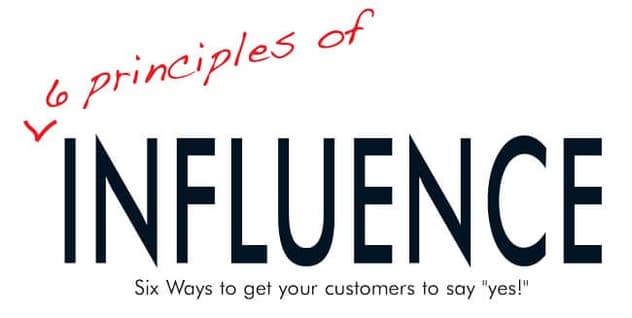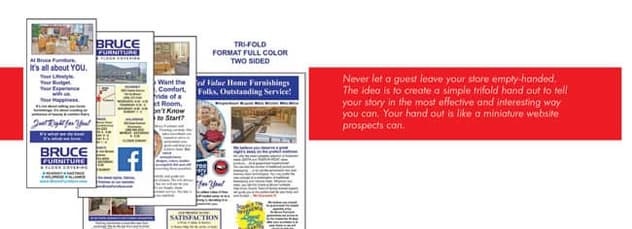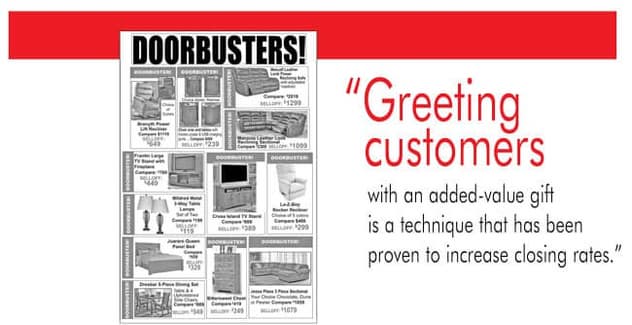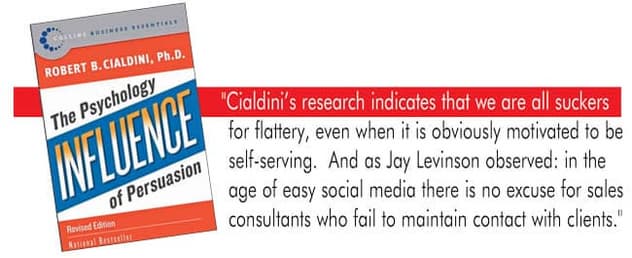
A number of years ago Dr. Robert Cialdini wrote a best seller titled: Influence. It is rich with promotional
ideas yet surprisingly few furniture retailers noticed it.
The Big Boxes were predictably clueless. Dr. Robert Cialdini's book "Influence" was a bit sophisticated for them. They continued doing what they always do: race to the bottom with price-item presentations, extended no-interest terms, same-old, same-old. Independent furniture stores generally followed them. This article will address ways to legitimately apply the lost secrets of influence to your furniture store and get customers to say “yes!”
Unused Secrets of Influence
Soon after Dr. Cialdini embarked on a three-year study of the ways people get other people to comply with their wishes, he found that there are people who know where the tools of automatic influence lie. Furthermore, they employ these tools regularly in social encounters to expertly get what they want; with dazzling success.
The secret of their effectiveness lies in the way they structure requests, and the way they arm themselves with the tools of influence that exist within the social environment. To do this may take no more than one correctly chosen word, to engage a strong psychological principle, setting an automatic behavior response rolling within prospective customers.
I should make it clear that Cialdini’s key principles can be applied with honesty and integrity. They are:
- Consistency and Commitment
- Reciprocation
- Authority
- Scarcity
- Social Proof
- Liking
When these principles are employed with veracity, they can have remarkable impact on the bottom lines of furniture stores.
Consistency & Commitment
Furniture retailers have a unique advantage when prospects walk into their stores. Shoppers have already made a commitment to at least see what they have going on. As tiny as this advantage may seem to be, it is important.
Even more important for retailers is how, once customers are in the store, to establish and preserve a consistent brand image in a world of advertising clutter? We all know when people shop for furniture they end up being confused about what they saw and where they saw it. To send a consistent, vibrant branding message, make this your mantra: Never let a guest leave the store empty-handed. Better to rely on your own personal presentation than manufacturers’ materials. One effective way to do this is to create a tri-fold brochure to hand out to your guests as a cost effective and informative reminder.

The idea is to tell your story in the most interesting way you can. Your handout is like a miniature of your website messaging that prospects can take home. It will provide your contact information, attractive photos, a bit of history, credit information, brands, your business philosophy, etc.
Here is a sample of a brief and effective philosophical brand presentation: “Since we started business in [date], the purpose of our store has been to improve the lives of our guests by offering honest values in home furnishings, provide outstanding service, and be a source of helpful information. We are the primary hometown store for the [city name] area, and the most trusted source for products, and advice.”
Be consistent. Nothing demonstrates consistency more powerfully than effective follow-through when you are promoting.
Few stores are aware of how disappointed shoppers are when after having been attracted to a store-wide event by strong media promising something special, they see that nothing has changed! The media spend established expectations. It promised that shoppers would see exciting, unusual displays and exceptional values. All other things being equal, if your advertising produces good traffic but sales are disappointing it is because prospective customers did not see what they expected to see.
On the other hand, if the store is aggressively signed, has bright sales tags everywhere, and if the staff is upbeat and “in the zone,” excitement and buying fever will be set into motion. Some store owners are aghast at the idea of a “messy” store. Yet Stephanie Clifford wrote in the New York Times: “After the recessionary years of shedding inventory and clearing store lanes for a cleaner, appealing look, retailers are reversing course and redesigning their spaces to add clutter.”

A few years ago Wal-Mart engaged in a failed store makeover. Its purpose was to try to retain Target customers who had traded down to Wal-Mart during the recession. The stores reduced the number of items it carried by nine percent hoping to avoid overwhelming their customers. Customer satisfaction scores spiked. And conversely, sales went into a long sustained decline. Wal-Mart’s CEO for the U.S.A. explained that though customers loved the shopping experience, they bought less. Wal-Mart reversed course and re-introduced clutter. Clifford concluded that the messier and more confusing a store looks, the better the deals it projects. The conclusion was that Americans simply like piles of “stuff.”
Rule Of Reciprocation
This rule employs the social impulse to try to repay, in kind, what another person provides. It seems to me that the best time to provide something for a guest (customer) is when you greet them. It is also the most difficult time; it’s hard to “break the ice” without seeming pushy. We all know we should avoid the tired old: “May I help you?” which almost always shuts down communication with: “We're just looking.”
One strategy that has proven to be successful is to come up with a list of 30 or so hot items you can show to prospects saying, “Would you folks like to know about some unadvertised doorbuster items that will save you a lot of money? Just let me know if you see anything interesting on the list and I will be happy to show it to you.” The list can include odd lot items and also regular stock merchandise with robust comparatives. This technique has proven to be effective in increasing closing successes. (see the doorbusters exhibit on the following page.)
Rule Of Authority
The traditional accouterments of authority still work.
Mattress advertisers still try to lure customers with bewildering ads that show massive selection, confusing pricing, and descriptions that may as well be in a foreign language. No mention of expert guidance to help select the right mattress. If you do provide expert guidance it should be stated in all your advertising. A simple certificate indicating that a sales consultant is “factory trained” and can guide guests to the right bed works wonders. Of course, the statements must be true.
Titles are important. Over the years the term “salesperson” has evolved into the more authoritative title, “sales consultant.”
Dress Code: In the old days Curtis Bros. in Washington, DC was the largest furniture store under one roof in America. They established a simple dress code for sales consultants: Identical blazers with attractive “CB” emblems, and black pants. Today the norm in retail is a casual “anything goes.” Curtis Bros. was a good middle of the road store, however, it treated ordinary folks as though they were high end guests. Did the dress code matter? According to Cialdini’s research a “uniform” matters a great deal. Tests proved that people obediently followed directions from uniformed individuals while they tended to ignore people in plain clothes. The “uniform,” so to speak, added an air of authority and professionalism to the sales consultant.
Rule Of Scarcity
We are all familiar with this one. Either time is running out or merchandise stock is limited. Buy now or never! Selection is going fast. Collectors of everything from baseball cards to antiques to postage stamps are aware that flawed items, such as misprinted stamps or the double-struck coins, are sometimes the most valuable of all.
Some furniture sales consultants purposely mislead prospects by telling them an item is in short supply, They may falsely inform prospects that the only available stock is the floor model the shopper is looking at, and one other in the warehouse. Or, they may use a “sharp angle close.” If a shopper asks, “Does it come in blue?” they respond with, “Do you want it if it does?” Such tactics are not recommended. When it's true, however, go ahead and announce limited stock and/or limited time. There are no more powerful motivators.

Rule Of Social Proof
I reported in a recent article that Jay Levinson made this startling statement regarding social media: “Modern technology gives small business a blatantly unfair advantage over the big boxes because it allows them to think and act big without having to spend big. The greatest boon to Guerrilla Marketing has been the affordable, powerful, easy-to-use technology of today. Technology is the game-changer that is revolutionizing small businesses. Now small business owners can dream extravagant new dreams and attain them in surprisingly brief time periods.”
Technology is your great equalizer against the Big Boxes. The prevailing policy in most corporate chains is that they will not allow franchises to host their own websites, or handle local social media accounts. This is true even though their IT departments are constantly overwhelmed with other priorities and rarely have time to help individual franchises. As a result, local franchises cannot compete with small independents who can employ simple technology such as Facebook to press an overwhelming Home Town Advantage. Levinson points out that modern technology is so inexpensive that today you can invest a low four-figure sum to receive what would have cost six figures in 1982.
Rule Of Liking
Joe Girard was known as “The World’s Greatest Salesman.” He said the secret of his success was that he was able to get people to like him. He did this by a follow up formula that may seem rash these days. Every month he sent ALL his former customers a greeting card containing a simple personal message. Joe used snail mail. In the age of Facebook and other social media opportunities his follow-up technique is virtually free. His message was “Happy New Year”, “Happy Thanksgiving” or something timely and appropriate. But his real message across the face of the card was always the same: “I like you.”
Could a message like that really sell cars? Cialdini’s research indicates that we are all suckers for flattery, even when it is obviously motivated to be self-serving. And as Jay Levinson observed: in the age of easy social media there is no excuse for sales consultants who fail to follow-up and maintain contact with their clients.
Robert Cialdini waited ten years before he decided to publish a new book titled: Pre-Suasion … A Revolutionary Way to Influence and Persuade. It lives up to its title. We will discuss it in the next issue of Furniture World.
Larry Mullins is a contributing editor for Furniture World and has 30+ years of experience on the front lines of furniture marketing. Larry’s mainstream executive experience, his creative work with promotion specialists, and mastery of advertising principles have established him as one of the foremost experts in furniture marketing. His affordable High-Impact programs produce legendary results for everything from cash raising events to profitable exit strategies. His newest books, THE METAVALUES BREAKTHROUGH and IMMATURE PEOPLE WITH POWER… How to Handle Them have recently been released by Morgan James Publishing. Joe Girard, “The World’s Greatest Salesman” said of this book: “If I had read Larry Mullins’ book when I started out, I would have reached the top much sooner than I did.” Larry is founder and CEO of UltraSales, Inc. and can be reached directly at 904.794.9212 or at Larrym@furninfo.com. See more articles by Larry at www.furninfo.com or www.ultrasales.com.